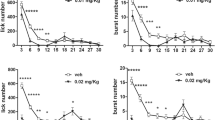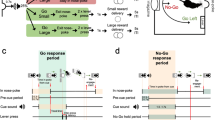Abstract
Rationale
We recently suggested that dopamine on D1-like receptors is involved in the activation of goal-directed responses and the level of response activation is “reboosted” on the basis of an evaluation process involving D2-like receptors assessing “response efficacy”. A main piece of evidence in support of this hypothesis was the observation of an “extinction mimicry” effect in the time course of licking bursts after dopamine D2-like receptor blockade in rats licking for sucrose.
Objectives
The aim of this study was to determine whether the pattern of licking observed with sucrose as a reward could be reproduced in rats licking for a different reward (0.9 % NaCl).
Materials and methods
We investigated the effects of the dopamine D1-like receptor antagonist SCH 23390 (0.01–0.04 mg/kg) and of the dopamine D2-like receptor antagonist raclopride (0.025–0.25 mg/kg) on the microstructure of licking for a 0.9 % NaCl solution in 12-h water-deprived rats in 30-min sessions.
Results
As previously observed with sucrose as a reward, raclopride reduced the size of licking bursts and produced on the burst number time course an “extinction mimicry” effect, while SCH 23390 reduced licking exclusively by reducing burst number.
Conclusions
These results are consistent with the proposed hypothesis and provide support to the use of the study of licking microstructure as a valid model not only for the investigation of the mechanisms governing ingestive behaviour but also for the investigation of the mechanisms underlying behavioural activation and the related evaluation processes.



Similar content being viewed by others
References
Baldo BA, Kelley AE (2007) Discrete neurochemical coding of distinguishable motivational processes: insights from nucleus accumbens control of feeding. Psychopharmacology 191:439–459
Berridge KC (2007) The debate over dopamine’s role in reward: the case for incentive salience. Psychopharmacology 191:391–431
Berridge KC (2012) From prediction error to incentive salience: mesolimbic computation of reward motivation. Eur J Neurosci 35:1124–1143
Berridge KC, Flynn FW, Schulkin J, Grill HJ (1984) Sodium depletion enhances salt palatability in rats. Behav Neurosci 98:652–660
Berridge KC, Venier IL, Robinson TE (1989) Taste reactivity analysis of 6-hydroxydopamine-induced aphagia: implications for arousal and anhedonia hypotheses of dopamine function. Behav Neurosci 103:36–45
Cannon CM, Palmiter RD (2003) Reward without dopamine. J Neurosci 23:10827–10831
Canu ME, Carta D, Murgia E, Serra G, D'Aquila PS (2010) Dopamine on D2-like receptors is involved in reward evaluation in water-deprived rats licking for NaCl and water. Pharmacol Biochem Behav 96:194–197
Cohen MX, Frank MJ (2009) Neurocomputational models of basal ganglia function in learning, memory and choice. Behav Brain Res 199:141–156
Cooper SJ, Higgs S (2005) Benzodiazepine effects on licking responses for sodium chloride solutions in water-deprived male rats. Physiol Behav 85:252–258
D'Aquila PS (2010) Dopamine on D2-like receptors “reboosts” dopamine D1-like receptor-mediated behavioural activation in rats licking for sucrose. Neuropharmacology 58:1085–1096
D'Aquila PS, Galistu A (2012) Possible role of dopamine D1-like and D2-like receptors in behavioural activation and evaluation of response efficacy in the forced swimming test. Neuropharmacology 62:1717–1729
D'Aquila PS, Rossi R, Rizzi A, Galistu A (2012) Possible role of dopamine D1-like and D2-like receptors in behavioural activation and "contingent" reward evaluation in sodium-replete and sodium-depleted rats licking for NaCl solutions. Pharmacol Biochem Behav 101:99–106
Davis JD, Smith GP (1992) Analysis of the microstructure of the rhythmic tongue movements of rats ingesting maltose and sucrose solutions. Behav Neurosci 106:217–228
Galistu A, D'Aquila PS (2012) Effect of the dopamine D1-like receptor antagonist SCH 23390 on the microstructure of ingestive behaviour in water-deprived rats licking for water and NaCl solutions. Physiol Behav 105:230–233
Galistu A, Modde C, Pireddu MC, Franconi F, Serra G, D'Aquila PS (2011) Clozapine increases reward evaluation but not overall ingestive behaviour in rats licking for sucrose. Psychopharmacology 216:411–420
Genn RF, Higgs S, Cooper SJ (2003) The effects of 7-OH-DPAT, quinpirole and raclopride on licking for sucrose solutions in the non-deprived rat. Behav Pharmacol 14:609–617
Gramling SE, Fowler SC (1986) Some effects of pimozide and of shifts in sucrose concentration on lick rate, duration, and interlick interval. Pharmacol Biochem Behav 25:219–222
Gramling SE, Fowler SC, Collins KR (1984) Some effects of pimozide on nondeprived rats licking sucrose solutions in an anhedonia paradigm. Pharmacol Biochem Behav 21:617–624
Haase H-J (1955) Psychiatrische Erfahrungen mit Megaphen (Largactil) und dem Rauwolfiaalkaloid Serpasil unter dem Gesichtspunkt des psychomotorischen Parkinsonsyndroms. Nervenarzt 26:507–510
Higgs S, Cooper SJ (1998) Evidence for early opioid modulation of licking responses to sucrose and intralipid: a microstructural analysis in the rat. Psychopharmacology 139:342–355
Iorio LC, Barnett A, Leitz FH, Houser VP, Korduba CA (1983) SCH 23390, a potential benzazepine antipsychotic with unique interactions on dopaminergic systems. J Pharmacol Exp Ther 226:462–468
Keitz M, Martin-Soelch C, Leenders KL (2003) Reward processing in the brain: a prerequisite for movement preparation? Neural Plast 10:121–128
Köhler C, Hall H, Ogren SO, Gawell L (1985) Specific in vitro and in vivo binding of 3H-raclopride. A potent substituted benzamide drug with high affinity for dopamine D-2 receptors in the rat brain. Biochem Pharmacol 34:2251–2259
Liao RM, Ko MC (1995) Chronic effects of haloperidol and SCH23390 on operant and licking behaviors in the rat. Chin J Physiol 38:65–73
Missale C, Nash SR, Robinson SW, Jaber M, Caron MG (1998) Dopamine receptors: from structure to function. Physiol Rev 78:189–225
Morris DA (1993) d-Fenfluramine and the microstructure of licking in the rat. Unpublished PhD thesis, University of Birmingham
Morris MJ, Na ES, Johnson AK (2008) Salt craving: the psychobiology of pathogenic sodium intake. Physiol Behav 94:709–721
Niv Y, Daw ND, Dayan P (2005) How fast to work: response vigor, motivation and tonic dopamine. In: Weiss Y, Schölkopf B, Platt J (eds) Advances in neural information processing systems. MIT, Cambridge, MA, pp 1019–1026
Phillips PEM, Walton ME, Jhou TC (2007) Calculating utility: preclinical evidence for cost–benefit analysis by mesolimbic dopamine. Psychopharmacology 191:483–495
Robbins TW, Everitt BJ (2007) A role for mesencephalic dopamine in activation: commentary on Berridge (2006). Psychopharmacology 191:433–437
Salamone JD, Kurth P, McCullough LD, Sokolowski JD (1995) The effects of nucleus accumbens dopamine depletions on continuously reinforced operant responding: contrasts with the effects of extinction. Pharmacol Biochem Behav 50:437–443
Salamone JD, Cousins MS, Snyder BJ (1997) Behavioral functions of nucleus accumbens dopamine: empirical and conceptual problems with the anhedonia hypothesis. Neurosci Biobehav Rev 21:341–359
Salamone JD, Correa M, Mingote SM, Weber SM (2005) Beyond the reward hypothesis: alternative functions of nucleus accumbens dopamine. Curr Opin Pharmacol 5:34–41
Salamone JD, Correa M, Farrar A, Mingote SM (2007) Effort-related functions of nucleus accumbens dopamine and associated forebrain circuits. Psychopharmacology 191:461–482
Salamone JD, Correa M, Farrar AM, Nunes EJ, Pardo M (2009) Dopamine, behavioral economics, and effort. Front Behav Neurosci 3:13
Sanger DJ (1986) Response decrement patterns after neuroleptic and non-neuroleptic drugs. Psychopharmacology 89:98–104
Schneider LH, Watson CA, Davis JD, Smith GP (1989) Microstructural analysis of the inhibition of sucrose sham feeding by SCH 23390. Appetite 12:236
Schneider LH, Davis JD, Watson CA, Smith GP (1990) Similar effect of raclopride and reduced sucrose concentration on the microstructure of sucrose sham feeding. Eur J Pharmacol 186:61–70
Shore DM, Rafal R, Parkinson JA (2011) Appetitive motivational deficits in individuals with Parkinson’s disease. Mov Disord 26:1887–1892
Smith GP (2004) Accumbens dopamine mediates the rewarding effect of orosensory stimulation by sucrose. Appetite 43:11–13
Smith GP, Smith JC (2010) The inhibitory potency of SCH 23390 and raclopride on licking for sucrose increases across brief-access test. Physiol Behav 101:315-319
Wassum KM, Ostlund SB, Balleine BW, Maidment NT (2011) Differential dependence of Pavlovian incentive motivation and instrumental incentive learning processes on dopamine signaling. Learn Mem 18:475–483
Wise RA (2004) Dopamine, learning and motivation. Nat Rev Neurosci 5:483–494
Wise RA (2006) Role of brain dopamine in food reward and reinforcement. Philos Trans R Soc Lond B Biol Sci 361:1149–1158
Wise RA, Spindler J, deWit H, Gerberg GJ (1978) Neuroleptic-induced “anhedonia” in rats: pimozide blocks reward quality of food. Science 201:262–264
Zhang J, Berridge KC, Tindell AJ, Smith KS, Aldridge JW (2009) A neural computational model of incentive salience. PLoS Comput Biol 5(7):e1000437
Acknowledgments
This work was funded by Fondazione Banco di Sardegna.
Author information
Authors and Affiliations
Corresponding author
Rights and permissions
About this article
Cite this article
Galistu, A., D’Aquila, P.S. Dopamine on D2-like receptors “reboosts” dopamine D1-like receptor-mediated behavioural activation in rats licking for a isotonic NaCl solution. Psychopharmacology 229, 357–366 (2013). https://doi.org/10.1007/s00213-013-3110-0
Received:
Accepted:
Published:
Issue Date:
DOI: https://doi.org/10.1007/s00213-013-3110-0




